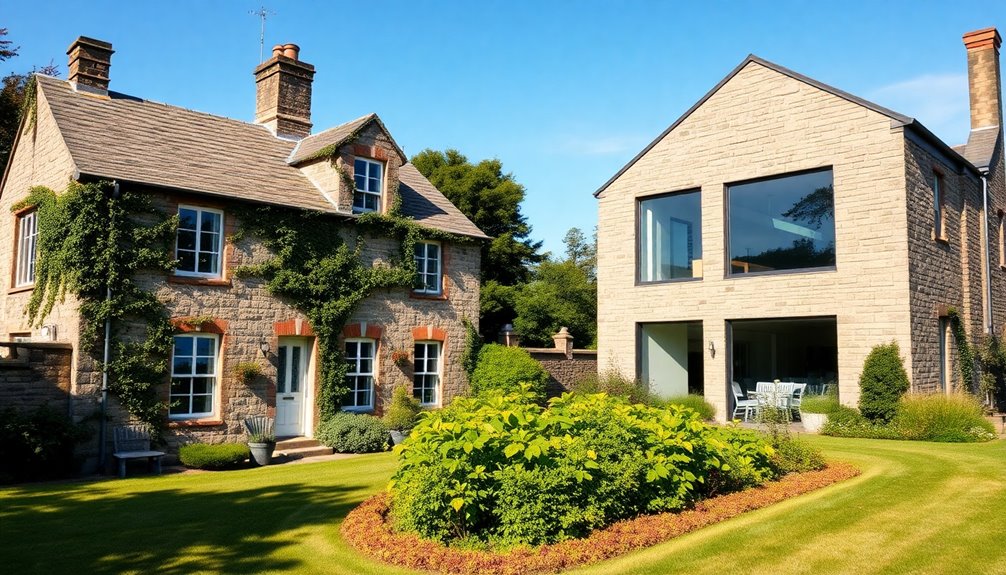Stone houses are a solid investment with numerous advantages. They offer exceptional durability, lasting for centuries and resistant to fire and pests. Their thermal mass helps maintain comfortable indoor temperatures and can lower your energy bills. Aesthetically, stone provides unique textures and blends seamlessly with nature. However, consider potential challenges, like higher initial costs and specialized labor requirements. Quarrying can have negative environmental effects, too. Weighing these pros and cons will help you decide if a stone house is right for you. To uncover more details about these timeless builds, keep exploring the various aspects of stone construction.
Key Takeaways
- Durability: Stone houses are highly durable, lasting hundreds to thousands of years with minimal maintenance, making them a long-term investment.
- Environmental Impact: Low embodied energy and local sourcing reduce carbon emissions, but quarrying can disrupt ecosystems and contaminate water sources.
- Aesthetic Appeal: Unique textures and colors of natural stone enhance the visual appeal and can harmonize with various architectural styles.
- Energy Efficiency: High thermal mass properties reduce heating and cooling needs, leading to lower energy consumption and increased comfort.
- Construction Costs: Initial costs can be high due to material and labor expenses, requiring skilled labor and robust foundations for stability.
Sustainability and Environmental Impact
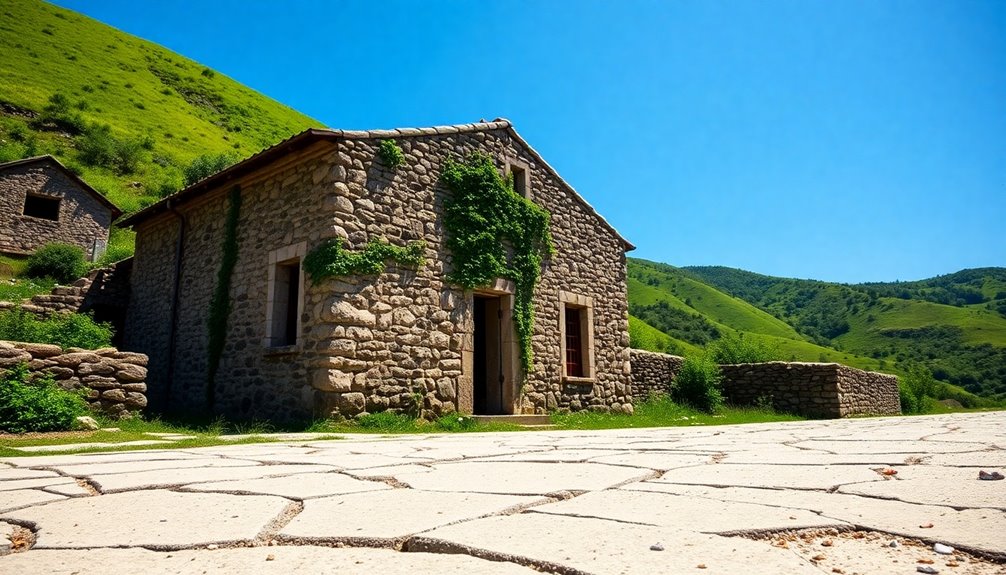
When you consider building with natural stone, its sustainability and environmental impact stand out as significant advantages.
Natural stone has low embodied energy, meaning it requires less energy for production, which translates to reduced carbon emissions. By sourcing stone locally, you minimize transportation emissions and support local economies. The material's thermal mass helps regulate indoor climates, cutting down on heating and cooling needs. Additionally, almost all deconstructed stone can be recycled or reused, drastically reducing waste. Natural stone is recognized as the most durable building material on Earth, ensuring longevity and reducing the need for frequent replacements. This durability is further enhanced by its ability to reduce carbon footprint over time, making it an eco-friendly choice for sustainable construction.
Many suppliers adopt sustainable practices, ensuring environmentally friendly handling of materials. With minimal water usage in production and no harmful chemicals involved, natural stone is a responsible choice that enhances both your living space and the environment.
Durability and Longevity
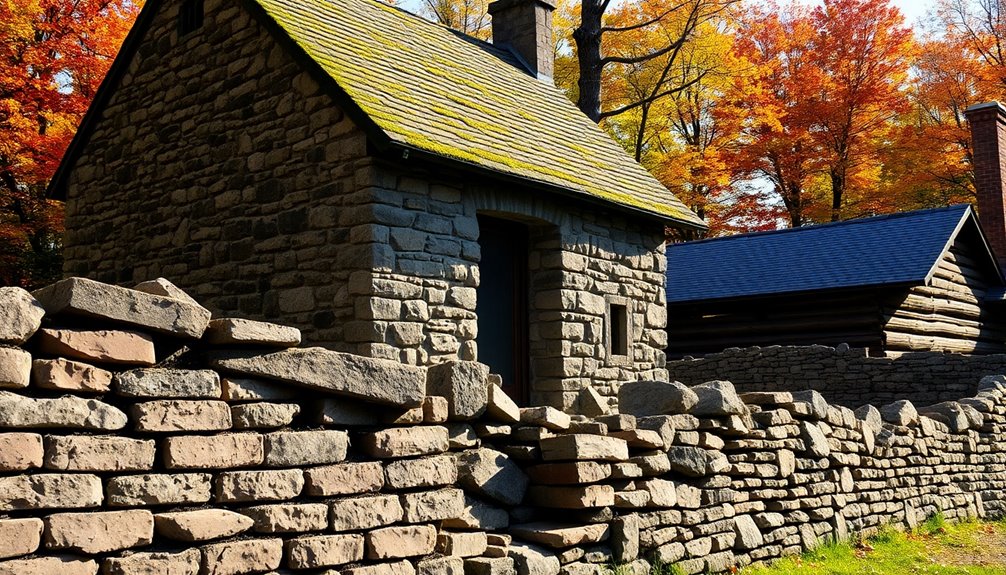
Natural stone not only stands out for its sustainability but also boasts remarkable durability and longevity. Its inherent strength makes it fireproof and resistant to pests, ensuring your home remains structurally sound over time. Stone withstands harsh weather conditions, lasting hundreds, even thousands, of years with minimal wear. Moreover, its non-porous nature means it resists moisture, heat, and freezing temperatures effectively. The high thermal mass of stone helps regulate indoor temperatures, enhancing energy efficiency and reducing heating and cooling costs. While regular maintenance is required, such as annual inspections and cleaning, these efforts can prevent costly repairs. With proper care, your stone home can remain beautiful and functional for generations to come.
Aesthetic Appeal and Design

While stone houses are celebrated for their durability, their aesthetic appeal and design truly set them apart. The natural stone exterior, with options like granite, limestone, and slate, provides unique textures and colors that enhance your home's beauty. These materials blend harmoniously with the environment, creating a timeless look that reduces visual impact. Inside, exposed stone walls and wooden beams foster a cozy atmosphere that invites warmth. Features like rustic fireplaces add to the charm, making your space feel inviting and full of character. Additionally, adding textiles such as burlap can complement the natural elements and enhance the farmhouse aesthetic. With architectural flexibility, stone houses can range from rustic to modern designs, allowing you to create a unique dwelling that reflects your taste while harmonizing with nature. Additionally, the use of locally sourced stone not only contributes to the aesthetic but also ensures the home is durable and energy-efficient.
Comfort and Insulation Benefits
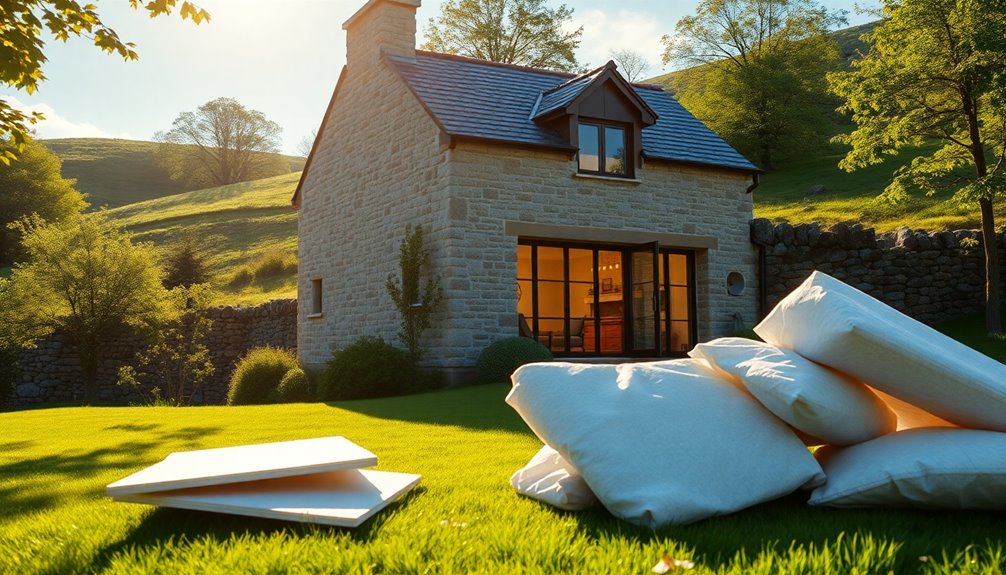
Stone houses offer impressive comfort and insulation benefits, primarily due to their high thermal mass properties.
Materials like granite and limestone absorb and store heat, regulating indoor temperatures effectively. This means your home stays cooler in the summer and warmer in the winter, significantly reducing the need for heating and cooling systems.
By stabilizing temperature swings, stone helps create a cozy living environment while lowering energy consumption by up to 25%. Additionally, the combination of thermal mass and insulation in stone structures enhances overall energy efficiency.
The natural density of stone also forms a robust barrier against heat loss, enhancing insulation.
When combined with proper insulation techniques, such as air gaps, stone cladding becomes an effective thermal barrier, further improving energy efficiency and comfort in your home.
Construction Challenges and Costs
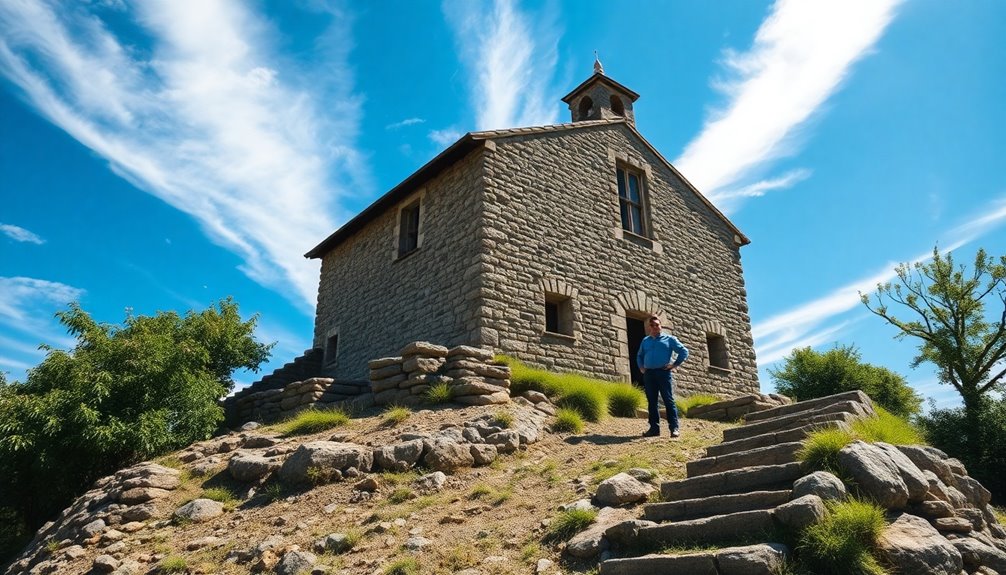
Building a stone house can present significant challenges and costs that homeowners should carefully consider. The upfront expenses can be high, with stone materials costing between $25 to $90 per square foot and labor ranging from $40 to $110 per hour. Overall, constructing a solid stone home averages around $380,000. Additionally, the durability of stone homes can justify the initial investment as they resist fire, insects, and moisture, leading to lower maintenance costs over time.
It's also a time-consuming process requiring skilled stonemasons, which can extend timelines and increase costs. Additionally, the heavy weight of stone demands robust foundations and specialized engineering, further driving up expenses.
Variability in stone size and shape complicates installation, requiring precise handling and potentially leading to delays. All these factors contribute to the complexity and financial commitment involved in building stone homes.
Maintenance and Upkeep

Maintaining a stone house requires regular attention to keep its beauty and integrity intact.
Start with daily dusting using a soft cloth or mop, and be sure to avoid harsh or acidic cleaners that can damage the stone. Clean up spills promptly by blotting them instead of rubbing, and steer clear of abrasive scrubbing pads.
If you have porous stone, sealing it's essential; consult professionals for the right sealant and re-seal every few years. Regular sealing can significantly reduce the risk of staining.
For stains, a water and baking soda mixture can help with organic stains, but test any cleaner beforehand.
Make sure to inspect your stone surfaces regularly and address any cracks or chips quickly to prevent further damage.
Design Versatility and Customization

When considering a stone house, you'll discover a remarkable design versatility that allows for endless customization options.
With various stone types like granite, limestone, slate, marble, and travertine, you can choose the perfect material to suit your aesthetic. Mixing and matching textures, such as blending rough-hewn stones with sleek surfaces, lets you create a unique look. Additionally, the durability of stone ensures that your design will stand the test of time, maintaining its beauty for years to come. Historical farmhouses often exemplify this concept, showcasing architectural significance through their enduring designs.
You can also incorporate other materials like wood or glass for added character. Whether you prefer a rustic charm or a modern edge, stone adapts beautifully to any architectural style.
Energy Efficiency Considerations
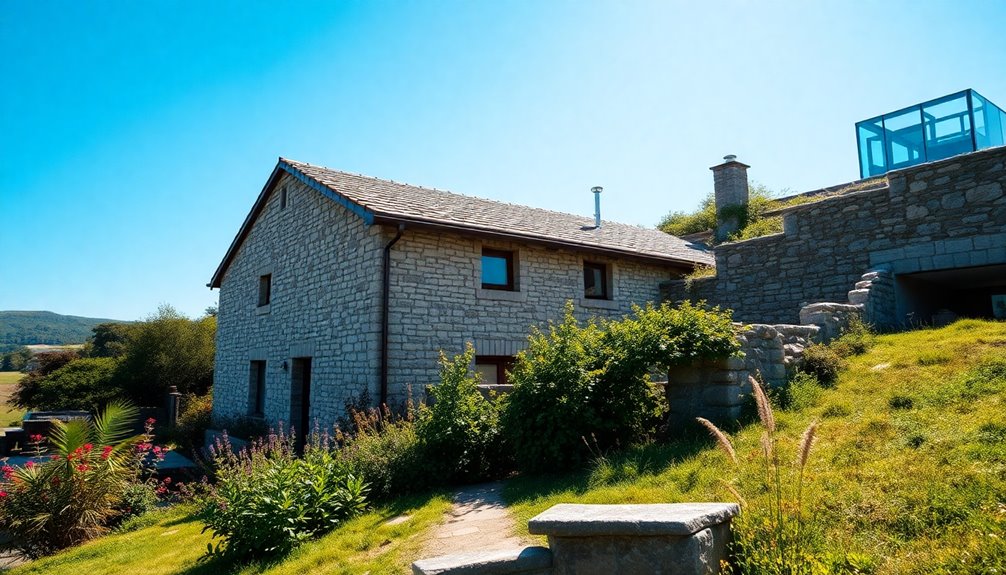
While energy efficiency mightn't be the first thing that comes to mind when considering a stone house, it plays a crucial role in long-term comfort and cost savings.
Stone's high thermal mass allows it to absorb heat during the day and release it at night, helping maintain a consistent indoor temperature. The natural density of stone significantly reduces heat transfer, which means you'll rely less on heating and cooling systems, lowering your energy bills. Combining stone with proper insulation maximizes these benefits, keeping your home cozy year-round. Additionally, the superior insulation properties of R-value stone contribute to maintaining stable indoor temperatures across seasons. Plus, with stone's durability, you can enjoy these energy savings for decades with minimal maintenance.
Negative Environmental Effects

Although stone houses are often praised for their aesthetic appeal and durability, they come with significant negative environmental effects that shouldn't be overlooked. Quarrying natural stone leads to land degradation and erosion, disrupting local ecosystems and diminishing biodiversity. The process can also result in chemical runoff, contaminating water sources and leaching toxins into groundwater, posing long-term risks. Additionally, transporting heavy stone contributes to high carbon emissions and resource consumption, as it often travels long distances. Moreover, the low embodied energy of cut-stone compared to synthetic materials highlights the potential for a more sustainable option, yet this advantage is often overshadowed by the environmental impacts associated with its extraction and transportation. The manufacturing process generates waste, which can further pollute the environment if not managed properly. Overall, while stone houses have their allure, their environmental footprint raises serious sustainability concerns that you should consider before making a decision.
Overall Value Assessment
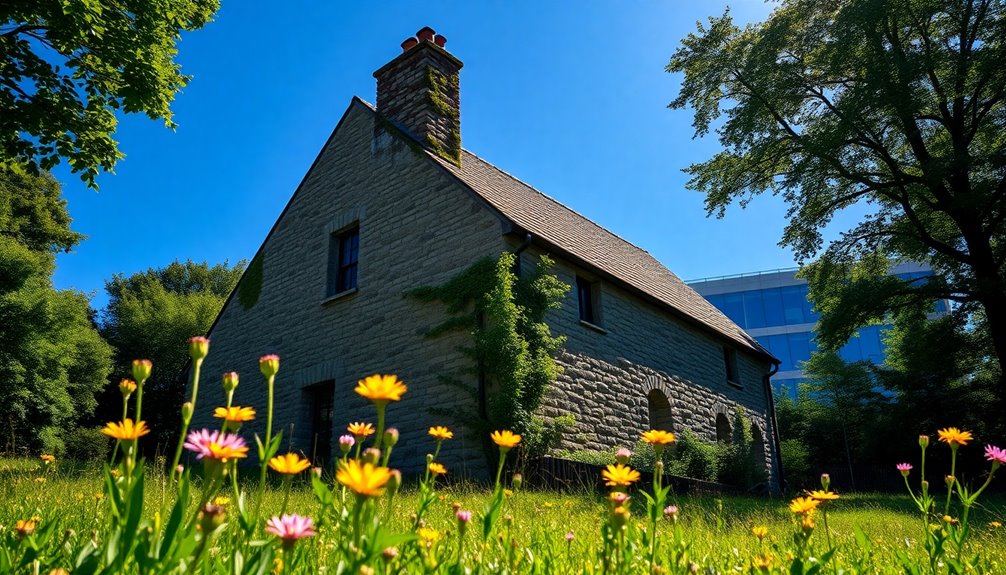
Understanding the overall value of stone houses involves a multifaceted assessment that goes beyond mere aesthetics.
You should consider material value, which is influenced by geographic location, accessibility, and the stone's quality and quantity. Engaging masonry-supply contractors can provide estimates on this aspect. The value of stone is often determined by factors such as the quantity and quality of the stone present.
Replacement value, determined by experienced stone masons, offers a practical minimum worth, often lower than material value due to its exclusion of historical significance.
Additionally, intangible value plays a crucial role; factors like sentimental connections, historical importance, and educational potential significantly enhance a stone wall's worth.
Finally, employing a real estate assessor for a market-based assessment can clarify how much value the stone houses add compared to properties without them.
Frequently Asked Questions
How Do Stone Houses Compare to Modern Building Materials?
When you compare stone houses to modern building materials, you'll find that stone offers unmatched durability and longevity.
It resists fire, pests, and extreme weather better than many contemporary options. Plus, stone's thermal mass helps regulate indoor temperatures, enhancing energy efficiency.
While modern materials might be cheaper and quicker to work with, they often lack the timeless aesthetic and sustainability that stone provides, making it a unique choice for your home.
Are There Specific Regions Best Suited for Stone Houses?
Imagine standing amidst the enchanting hills of Tuscany, where stone houses rise like ancient warriors against the sunset.
You'll find regions like Piedmont, with its majestic mountain hamlets, and Puglia, showcasing unique Trulli structures.
Umbria's rustic charm captivates with thick-walled farmhouses.
Each area, bursting with character, embraces local materials that tell stories of craftsmanship and tradition.
If you're dreaming of stone, these regions are calling your name!
What Are the Best Types of Stone for Construction?
When considering the best types of stone for construction, granite stands out for its durability and resistance to weathering.
Basalt's high compressive strength makes it perfect for heavy loads.
If you prefer something more workable, limestone offers varied textures and colors.
Sandstone is another excellent choice, known for its toughness and aesthetic appeal.
Each stone has unique qualities, so you can choose based on your specific design and structural needs.
Can Stone Houses Be Modified or Expanded Easily?
You can modify or expand stone houses, but it isn't always easy.
You'll need to respect the original structure and use compatible materials to maintain aesthetic harmony. Careful planning is essential to avoid compromising the stone's integrity.
Consider incorporating innovative design elements like skylights to enhance natural light.
Engage skilled artisans for restoration work, as their expertise ensures that modifications align with both historical context and modern functionality. These professionals not only possess the technical know-how but also appreciate the nuances of preserving the aesthetic integrity of a space. By collaborating with skilled artisans, property owners can achieve a balance between historical appreciation and contemporary needs, similar to how one might consider a genie garage door opener review before making an upgrade. Ultimately, investing in their craftsmanship can result in a seamless blend of old and new, enhancing the overall value and appeal of the property.
How Do Weather Conditions Affect Stone Houses Over Time?
Weather can be a relentless artist, sculpting stone houses over time.
You'll find that their durability shines through, resisting wind, rain, and snow like a steadfast sentinel.
While humidity might dance around them, proper waterproofing ensures they stay dry and strong.
With minimal maintenance, these homes withstand centuries of weathering, maintaining their beauty and structural integrity.
Conclusion
In the end, stone houses stand as both castles and challenges. They offer timeless beauty and durability, whispering tales of ages past while promising a cozy haven for your family. Yet, the cost and construction hurdles might feel like navigating a labyrinth. Ultimately, weighing their pros and cons is like deciding between a sturdy fortress and a fleeting trend. If you value lasting charm and sustainability, a stone home could be your perfect retreat from the ordinary.
